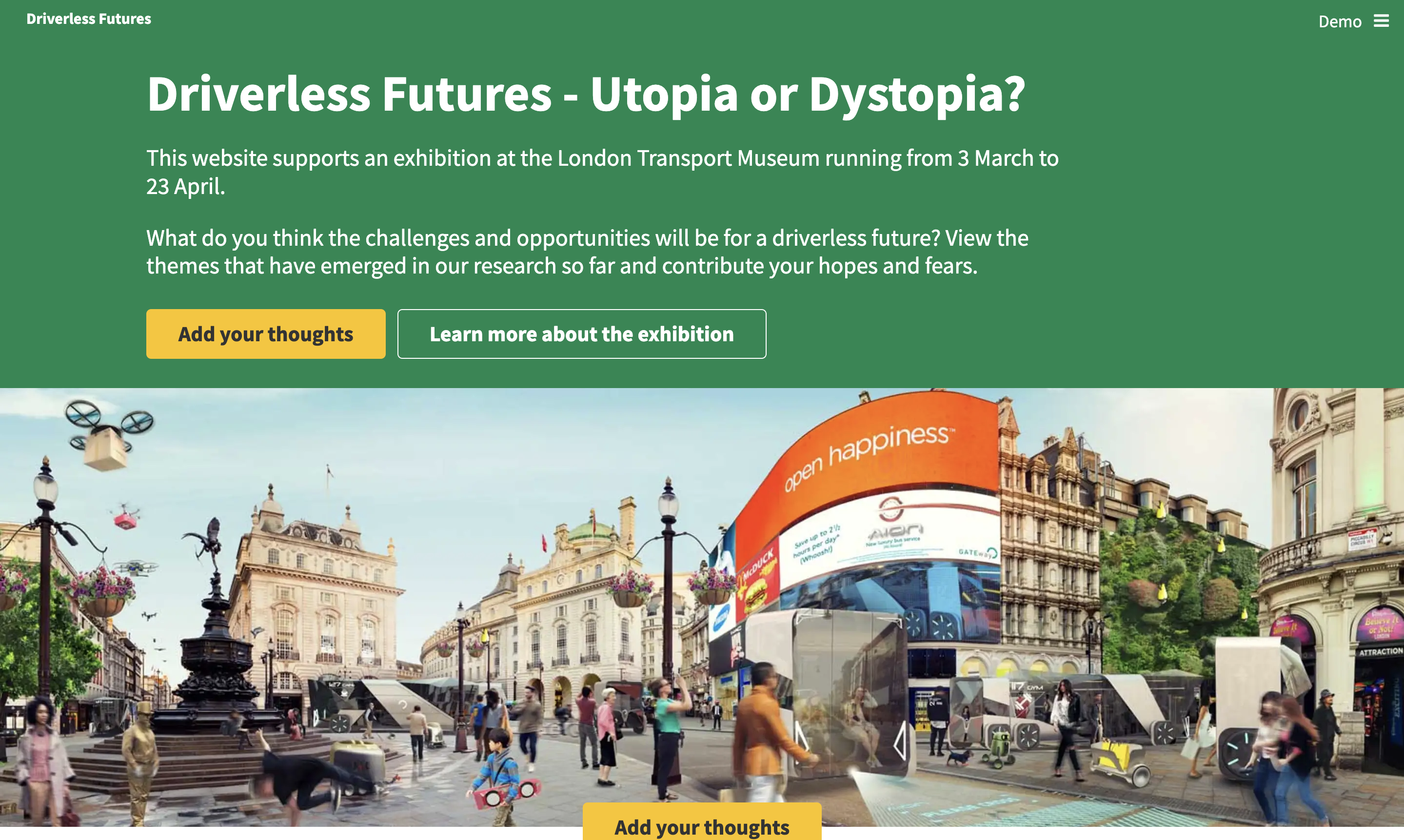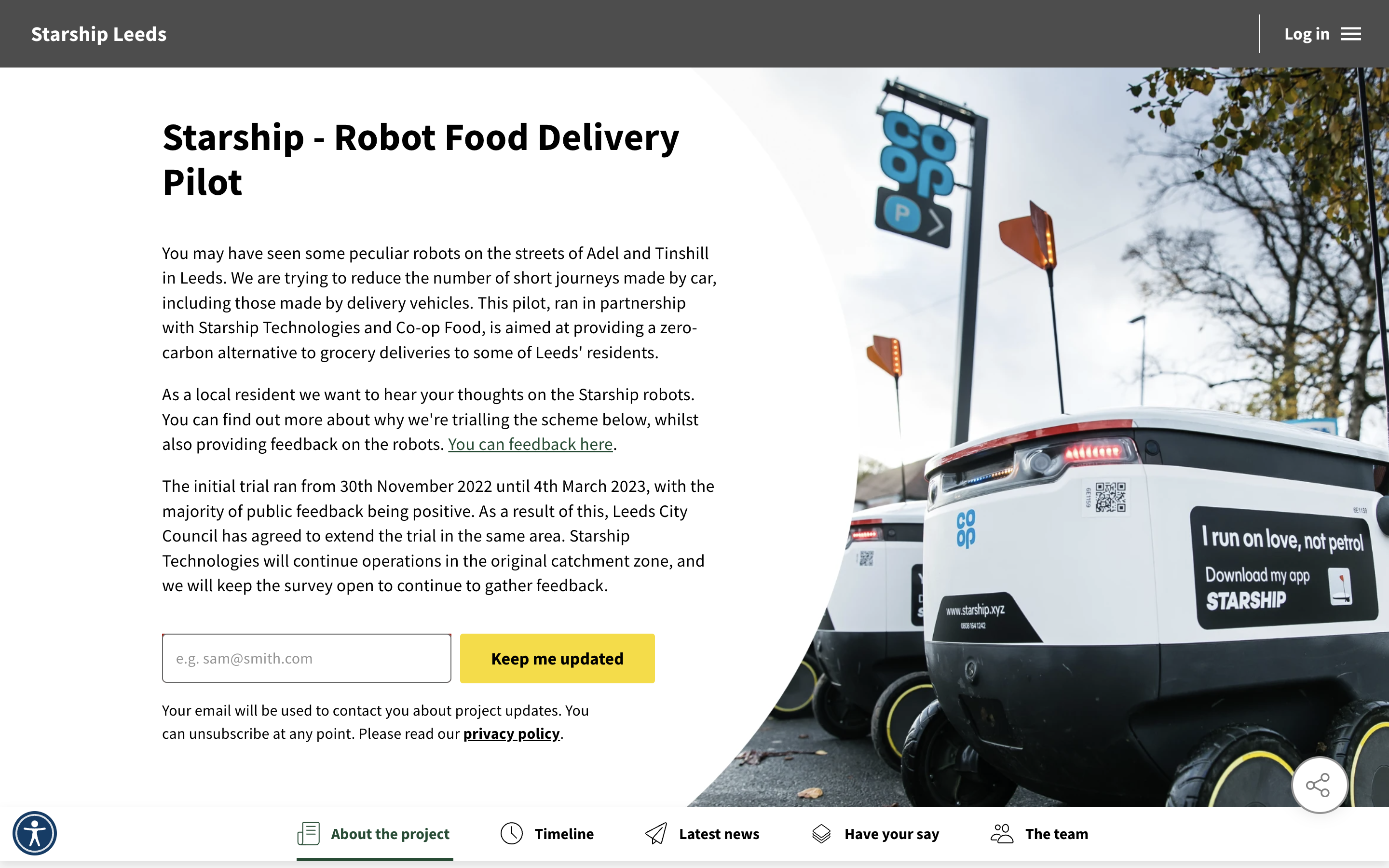The pioneers of public realm robots

By David Janner-Klausner | Fri, Jul 14, 2023
5 min read
The robots are among us - how do we feel? The pioneers of public realm robots are turning to Commonplace to understand the community’s response to robots on our streets and in the skies.
Driverless vehicles; delivery drones; flying taxis and delivery robots are all being rolled out across the country. This may feel tentative and experimental now, but some of these technologies could be adopted very quickly, driven by opportunities to improve efficiencies, reduce pollution and emissions and be of great convenience to the public. At the same time, the regulatory framework and the form of the “societal pact” that will govern the operation of robots in the public domain is still evolving. Here is one basic set:
First Law - A robot may not injure a human being or, through inaction, allow a human being to come to harm.
Second Law - A robot must obey the orders given to it by human beings except where such orders would conflict with the First Law.
Third Law - A robot must protect its own existence as long as such protection does not conflict with the First or Second Law.
Recognise these? The famous “Three Laws of robotics”, Isaac Asimov’s creation from his book “I, Robot'' back in 1950. Now, 73 years later, robots are everywhere - but in both a similar and different way than people may have imagined back then. Mostly they are invisible - “bots” that control what we see online, or provide digital customer service. Arguably, Asimov’s laws did not anticipate algorithms and recent experience suggests that these often operate well outside the three laws. But the Three Laws still form an intriguing frame of reference for robots that will increasingly become a physical presence in our public realm and our skies. That future is almost here.
Before robots can share the public realm at scale, they need a degree of public acceptance that online bots may have avoided. To this end, the UK is seeing a variety of experiments to test public opinion and to surface any potential unintended consequences of operating physical robots in everyday human activity.
The pioneers of public realm robots are turning to Commonplace to understand the public response to robots on the street and in the skies as part of everyday life. Here are the projects we’ve worked on and a bit about what we have learnt.
Driverless passenger vehicles

Our inventory is diverse, starting with driverless car trials on Greenwich Peninsula. The GATEway project was one of several pioneering experiments to test driverless vehicles in urban environments. A multi-industry working group was an essential part of GATEway, including local authorities, technologists, the insurance industry and others.
Commonplace websites enabled the general public to express their hopes and concerns about the technology generally and then to comment on the specific experience of riding in the driverless pods or encountering them on the Greenwich peninsula (by the O2 Centre).
- https://gateway.commonplace.is/
- https://driverlessfutures.commonplace.is/
- https://ratemydrive.commonplace.is/
Taking to the skies
Commonplace is involved in two flying robots - or drone - projects. Earlier this year, we provided the online feedback platform for the AirOne event in Coventry, which introduced the world's first operational hub for future electric Vertical Take-Off and Landing (eVTOL) vehicles – such as air taxis and unmanned delivery drones.
In Scotland, Commonplace is gathering the public’s reactions to project CAELUS - which is using cargo drones to fly medical supplies to rural and remote communities in Scotland. The use of drones can save time, resources and as they are electrically propelled, also CO2 emissions. The Commonplace website enables local people to address a variety of key aspects in this trial - benefits; some hurdles; the legal framework, and more. Through this website, the project managers can maintain contact with the public and quickly respond to pertinent observations.
(For general information on project CAELUS, please visit the project’s information website. )
Sharing the pavement - local delivery robots

Our most recently launched robot project takes us back to earth - scooting around Leeds making grocery deliveries. This deployment addresses some of the challenges of last-mile deliveries - it is small, electric and very manoeuvrable, so it is able to bring goods to the doorstep from a local shop or chemist. A very interesting sight when using the zebra crossings for sure!
https://starshipleeds.commonplace.is/
What people are saying
Overall, Commonplace respondents are positive about the projects we have worked on, but there are some emerging distinctions. There is positive sentiment for the two drone projects and strong positive sentiment towards the driverless vehicles that were trialled in Greenwich. Sentiment on the delivery robot project, while still positive, is more tempered.
Positive attitudes prevail in all age groups, from young to old - it is an almost flat line. That is telling in itself - while benefits may differ in different age groups, there is an overall sense that these technologies can improve lives.
What does make some difference to attitudes, though, is encountering the robots in operation. The two Commonplaces where people’s responses are perhaps more nuanced are the driverless car and the delivery robot trials.
.png?width=3000&height=1260&name=Plymouth%20and%20South%20West%20Devon%20Joint%20Local%20Plan%20(3000%20%C3%97%201260px).png)
When it comes to the driverless vehicles, people who are considering their impact in advance of the trials - so responding to the promise of the technology - were more positive than those experiencing it in reality. In contrast, opinions about delivery drones and air taxis are based almost purely on the potential - people have virtually no experience of these technologies in their immediate environment.
These are early days for data gathering on robots. Commonplace data so far suggests:
1. That people are positive about the promise of the technologies. This is very evident in the “Driverless Futures” Commonplace, where people were asked about how driverless cars might improve their lives. It is also apparent in the initial responses to the Caelus project.2. When experienced, the robots are not yet fulfilling their perceived potential. This is hardly surprising as the technologies are still very much in their infancy. The trials of the driverless pods in Greenwich, for example, were between a car park and the O2 Centre - whereas people were envisioning the convenience of knowing that frail relatives could get to doctors’ appointments. The criticism of the delivery robots is partly about their current limitations - they are small, and associated with a local shop that has a limited range of goods. The frame of reference seems to derive from a supermarket weekly shop delivery, rather than a top-up shop.
3. There is no inherent mistrust of the technologies that we’ve been assessing - quite the opposite. It seems more a case of not to over-promise, and ideally adapting the technologies to locations where they match lifestyles. For example, an area with a young demographic that uses delivery services for occassional shopping items might be less bothered by the limitations of the delivery robots involved in the current trial. This is supported by some earlier deployments of Starship delivery robots on US university campuses.
It should be noted that local delivery robots are operating something of a legal vacuum in the UK and many other countries. Rather like the introduction of electric scooters, the phasing-in of a new mode of transportation can upend the existing rules that apply to drivers, cyclists and pedestrians. Hence, like electric scooters, delivery robots are being introduced under experimental regulations and on a fairly small scale (although some 200 are deployed in Milton Keynes). Asimov’s laws may form a good ethical starting point, but trying to work out priority at crossings adds a whole layer of complexity. It is the kind of detail that could well have stalled Asimov’s narrative arc!
This takes us back to the importance of Commonplace. The point of the experiments and pilot projects is to obtain public reactions and also inform the public. This ensures that the subsequent debate on the operational frameworks is informed, and accountable and the public is engaged in it. Commonplace, through its transparency and immediacy, provides an excellent partner for new robot trials. We look forward to supporting entrepreneurs and the public in developing a framework for these new technologies.
Looking to do some robotic testing of your own? Make sure to book a free chat with our team using the link below.
Sources -
International comparison of attitudes
- Singapore - https://www.frontiersin.org/articles/10.3389/fpsyg.2022.953370/full
- Tehran - https://www.tandfonline.com/doi/abs/10.1080/03081060.2022.2134127?journalCode=gtpt20
- Starship - review of use on campuses - https://www.zdnet.com/article/these-figures-confirm-what-people-think-about-robot-delivery/
- Legal framework not ready - https://techmonitor.ai/technology/ai-and-automation/delivery-robots-coming-law-not-ready
.png)
